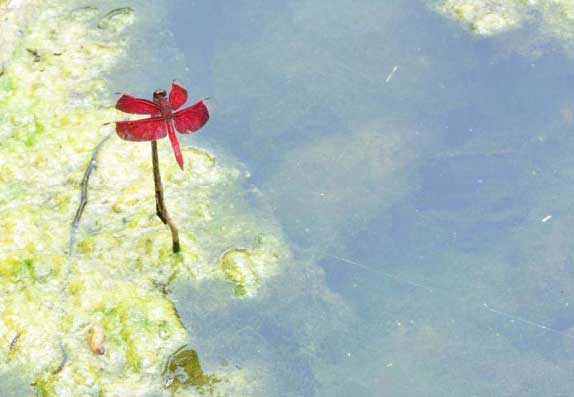Research teams left Lobo on Friday 31th October, an opportunity to review the field work so far. Here is an abstract on insects,
By Pungki Lupiyaningdyah & Endang Cholik
In Lobo, the Indonesian team only focused on Odonata (dragonflies). As there are presently no Odonata from the Lengguru region in the collections of the Museum Zoologicum Bogoriense, this expedition is expected to have high positive scientific value in terms of species representatives from the Lengguru karst area.
Ecologically, Odonata can be used as a bio-indicator for water quality. Near Lobo, the main water system is the Lengguru River, with several tributaries. These tributaries tend to be seasonal, which gives a unique characteristic to the Odonata habitat. The average stream width is around 3-6 m at this time of the year (during the dry season) and the average depth around 0-100 cm. The stream bed is muddy, sandy and with small rocks. The collection was done in three main locations: coastal area (0-1.5 km from the coastal line) and primary forests at km 8 and km 12 from the main base camp. The habitat at km 12 was drier, with clearer under storey, than in the other two localities.
The team collected 91 specimens representing 31 species. Most of them are from the families Libellulidae, in the sub-order Anisoptera (dragonfly), and Platycnemididae, in the sub-order Zygoptera (damselfly). Libellulidae are found more in Km 8, where the habitat is characterized by a stream with muddy and mossy pool water, open canopy space and slightly disturbed forest. Platycnemididae are found more in km 12, where the stream riparian is covered with vegetation and the water is relatively clear. But there is also some species which were found in the rivulet pools. Some species that were collected are difficult to find and collect, and seem to be rare. These species are Argiolestes sp., Drepanosticta sp., and Palaiargia sp. The endemic species that were collected are Rhinocypha tincta dentiplaga, Papuagrion occipetale, Teinobasis metallica, Idiocnemis chloropleura, Nososticta cyanura, and Nososticta xanthe.

Dragonfly © P. Lupiyaningdyah / LIPI

